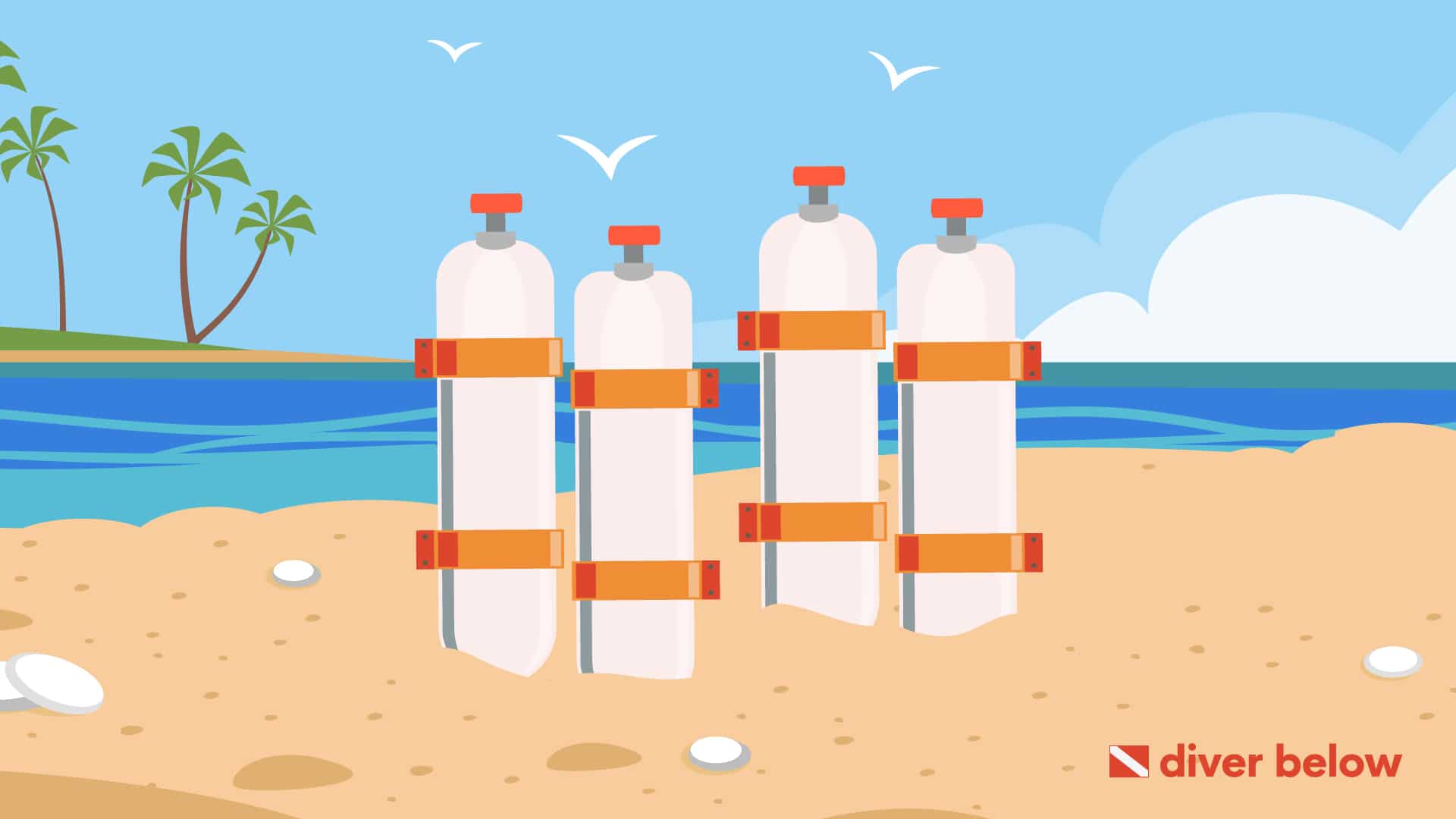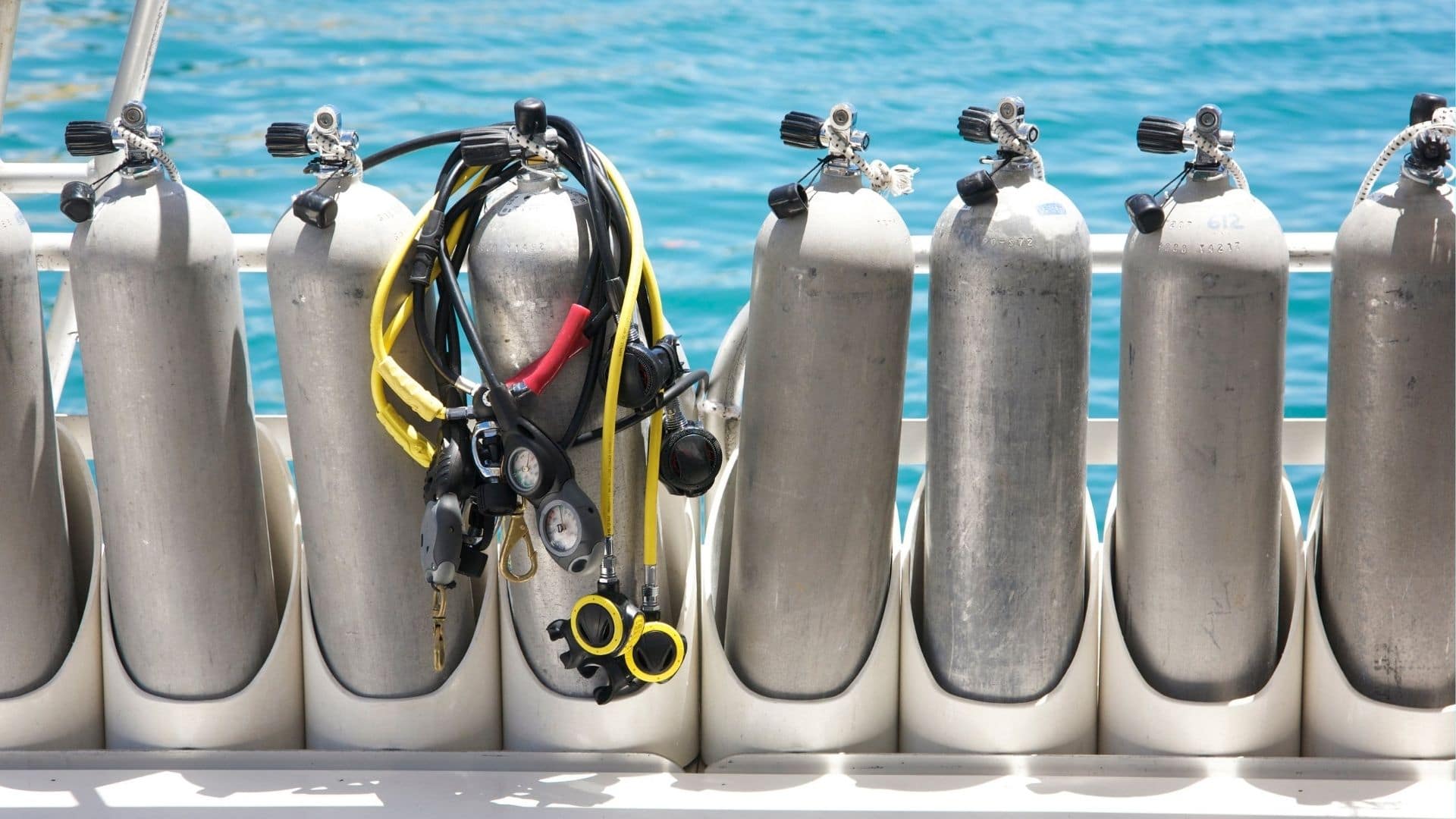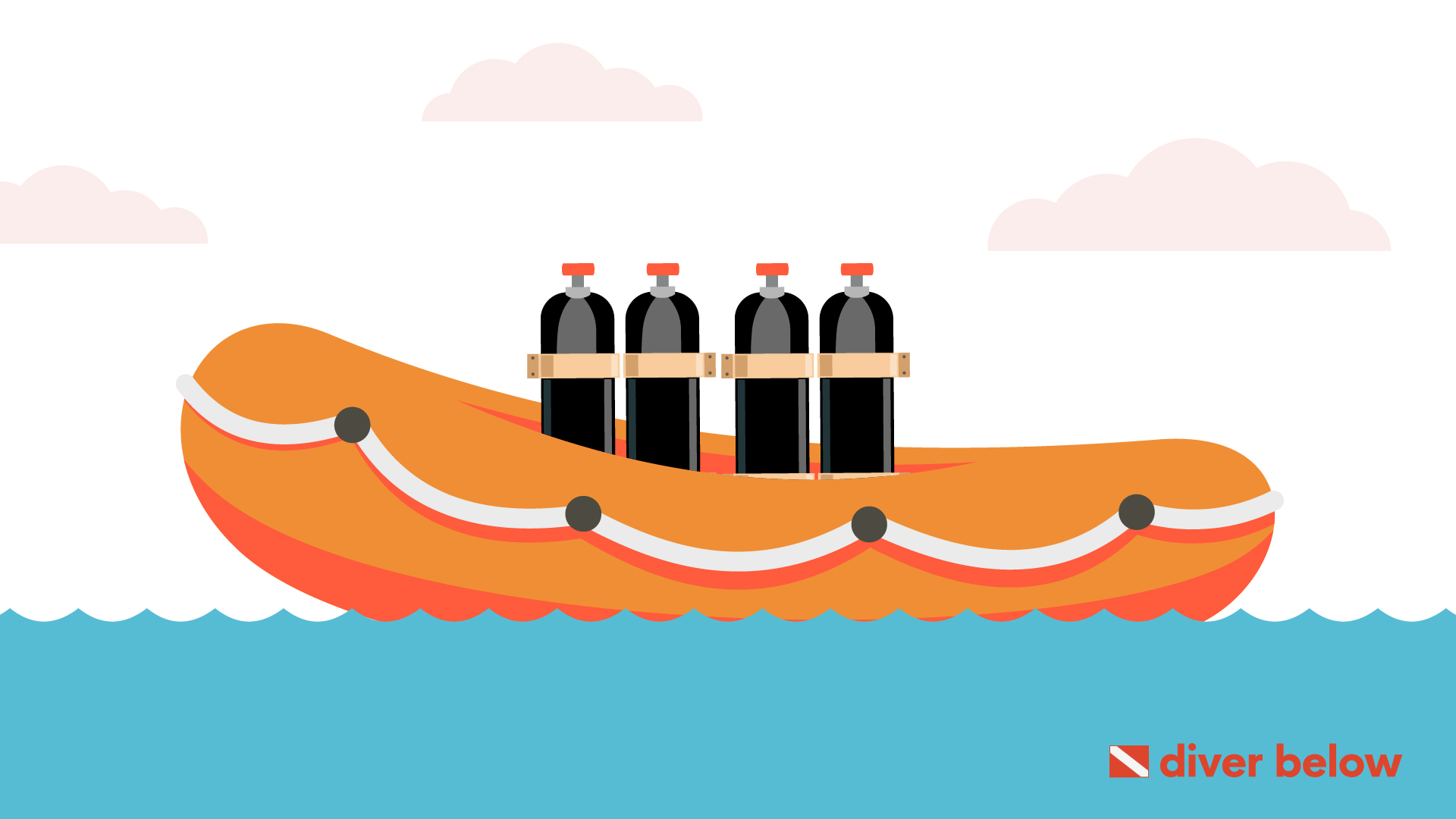Scuba diving is a fun and exhilarating activity.
However, you must have the correct scuba gear and accessories when you take on this sport.
One of the main things you will need to scuba dive is a Scuba tank.
Your scuba tank or cylinder is your source for air when you go underwater.
This article will teach you most of the information you need to know about scuba tanks, cost, materials, potential dangers, and maintenance requirements.
Let’s dive into the world of scuba equipment.
Contents
- What Is a Scuba Tank?
- How Do Scuba Tanks Work?
- Gas Inside of Scuba Tanks
- How Long Does a Scuba Tank Last?
- Different Sizes of Scuba Tanks
- What Are Scuba Tanks Made Of?
- How Heavy Are Scuba Tanks?
- How Many Scuba Tanks Do You Need?
- Where to Buy a Scuba Tank
- How Much Do Scuba Tanks Cost?
- How are Scuba Tanks Filled?
- Scuba Tank Safety
- Wrapping Up
What Is a Scuba Tank?
A scuba tank is a gas cylinder that provides storage for the high-pressure gas used during a dive.
You will use this dive tank for breathing underwater.
When deciding on a scuba cylinder, divers can choose from steel tanks or aluminium tanks.
How Do Scuba Tanks Work?
Scuba tanks provide storage for the high-pressure gas that divers need to breathe underwater.
These tanks contain cylinder valves that can burst and release pressure.
Each tank valve is known by a specific letter, K-valve, Y-valve, and H- valve.
- Gas flows in and gets shut off by the K-valve.
- Regulators are attached to the H and Y valves.
Gas Inside of Scuba Tanks
Believe it or not, the gas inside of a scuba tank can vary by diver preference, dive type, and more.
Air
To breathe underwater, human divers, of course, must have some type of air.
The air in the scuba tanks contains about 20.9% oxygen and 79% nitrogen.
Are scuba tanks pure oxygen?
Contrary to what some may believe, scuba tanks don’t contain pure oxygen.
This is due to health concerns.
The use of pure oxygen could result in (CNS) or central nervous system oxygen toxicity.
Oxygen becomes toxic at certain depths.
Mixing oxygen with a different gas can help extend how deep you are allowed to dive.
It is also more cost-effective to combine oxygen with another type of gas.
Nitrox
Another commonly used gas used in diving cylinders is air nitrox.
This gas has 22% to 40% oxygen.
This gas is for shallow diving; it is not ideal for a deep dive.
Recreational divers at busy resorts will find that this is the most widely available gas mix.
How Long Does a Scuba Tank Last?
The depth of the dive directly affects how long the air in your tank will last.
Once an average diver has reached 10 meters and has been in the water for an hour, the tank will likely be empty or close to it.
As you become a more experienced diver, there are techniques you can use to reduce air consumption.
Buoyancy control and controlled breathing help reduce the amount of air you use during a dive.
Different Sizes of Scuba Tanks
A SCUBA tank is measured in cubic feet with a standard size of 80 cu ft.
However, you can purchase a steel cylinder in various sizes, such as 3, 5, 7, 9, 10.5, 12.2, 15, and 18 litres.
What Are Scuba Tanks Made Of?
Scuba tanks can be made of different materials, which depend on how big the tank is and how sturdy it needs to be.

Steel Tank
Unlike aluminum, a steel tank can rust due to moisture.
You must take proper care when filling a steel cylinder with gas.
Improper fill procedures may cause moisture to get into the tank and cause internal corrosion.
Steel tanks have a greater need for a cylinder boot as well.
The tank boot protects the bottom of the tank, and since steel tanks have round bottoms they are also essential in allowing the tank to stand up on flat surfaces.
Aluminum Tank
An aluminum cylinder is softer than a steel one.
So, it is more susceptible to dents and scratches.
The walls of an aluminum tank are thicker than those of a steel tank.
This increased thickness allows an aluminum tank to hold air at the same pressure level as a steel one.
How Heavy Are Scuba Tanks?
The dry weight ( how much it weighs on land) of any tank can be between 25 and 36 lbs.
Since aluminum tanks have thicker walls, a steel scuba tank is actually lighter than an aluminum one.
Are Scuba Tanks Heavy?
A Scuba tank will only feel heavy on land.
As stated above, a tank can weigh 25 to 36 pounds on land.
However, a specialty tank can have a dry weight of up to 40 lb.
Regardless of a tank’s dry weight, it won’t matter once you dive.
Your tank is mostly weightless underwater.
Are Scuba Tanks Buoyant?
Buoyancy refers to how or why a SCUBA tank can float.
A steel cylinder has negative buoyancy.
On the other hand, an aluminum one achieves buoyancy as it becomes empty.
An empty air tank can play a role in diver movement, especially at the end of a dive.
As air goes out of the tank, the upward force that pulls the tank to the surface becomes stronger.
This does not affect a steel tank.
However, a diver with an aluminum tank will get pulled towards the surface as it empties.
How Many Scuba Tanks Do You Need?
You may have heard the term “two tank dive”.
It does not mean that a scuba diver actually uses two tanks at the same time.
A diver will dive with the first tank for as long as possible.
After coming to the surface for a rest, a diver will use the second tank.
Since your recreational dive most likely covers at least two dives in a day, you should rent or buy two tanks to bring with you.
Where to Buy a Scuba Tank
When it is time to get a SCUBA tank, you have the option of renting or buying one.
You can rent your tank at the diver shop.
This frees you from worrying about the maintenance or upkeep of your cylinders.
Renting a tank is also more sensical if you travel to your scuba dive locations.
However, you may want to own your equipment for deep technical dives or frequent recreational ones.
If you live or dive far away from a dive center, owning is also the best option.
You can buy a brand new scuba tank and valves at online sources such as Scuba.com and Amazon.
If you want to save money, go on eBay or Craigslist to purchase a used scuba cylinder.
Bear in mind that a used tank may need a hydro inspection or have internal damage such as rust or corrosion.
Check for external damage to ensure your tank passes inspection.
How Much Do Scuba Tanks Cost?
An aluminum tank is cheaper to buy than a steel tank.
However, it may be worth investing in a steel tank since these can last for decades with proper care.
On the other hand, you may pay more overtime for the maintenance of a steel tank.
A steel tank is subject to rust, so you should pay for proper upkeep.
A Catalina 80 cubic foot tank made from aluminum costs around $200.
On the other hand, a high-pressure steel tank can range from $200 to slightly over $300.
It also costs money to refill your tank constantly.
You may pay around $5 to $8 for a standard air fill ( up to 3500 psi).
Let’s not forget about the visual inspection fees.
An annual inspection can cost $15 to $25.
When you have the hydrostatic inspection every five years, that will cost $20 to $25.
Some companies offer a bundle package that combines the services for one low fee.
Air Hogs Scuba will conduct a visual inspection, the hydrostatic test, and an air fill for the price of $55.
How are Scuba Tanks Filled?

Can You Use an Air Compressor to Fill a Scuba Tank?
Divers need breathable oxygen at high pressure.
So, we should use a proper air compressor specially designed to fill a scuba cylinder at about 3,000 psi.
Special scuba compressors are capable of purifying the air it goes into the tank.
Regular air compressors can only pump a fraction of that.
What Pressure Are Scuba Tanks Filled To?
3000 psi Is the standard rated pressure for these tanks.
Low-pressure tanks have 2400 to 2640 psi.
High pressure is reached at 3300 to 3500 psi.
Where to Refill Scuba Tanks
You can always fill your scuba tank at a scuba store, air supply provider, or local dive shop.
Maintaining a Scuba Tank
Like any other safety gear, your scuba tank requires proper care and maintenance.
You don’t have to worry about an annual visual inspection in the United States.
Make sure you check the manufacturing stamp of your tank.
Hydrostatic testing is required every five years from the date of that stamp.
Where to Get Scuba Tanks Hydro Tested
Divers must get their scuba tank Hydro tested every five years.
Go to a certified hydro testing facility since the Federal government regulates this certification.
Scuba Tank Safety

Are Scuba Tanks Explosive?
While scuba tanks are pretty safe, they are capable of exploding.
Bad maintenance practices such as leaving your tank in the sun or overfilling it can create dangerous pressure levels.
One unfortunate incident in 2011 involved the death of a Gulf War veteran when his scuba tank exploded.
Scuba tanks do not contain combustible gases – they have compressed air inside.
So they are unlikely to combust suddenly.
A puncture in the container can be the most likely cause of an explosion.
Trying to force too much pressurized air into a cylinder may throw internal pressure off and cause an explosion.
That is why it is best to have your tanks professionally filled since safety equipment gets used in the process.
Are Scuba Tanks Flammable?
No, scuba tanks are not flammable.
They do not contain flammable gas like hydrogen.
A fiery explosion could take place if a SCUBA tank combusts near an ignitable item.
After the famous climactic scene in the movie Jaws, many people mistakenly believe that scuba tanks are automatically flammable.
Despite the movie’s magic, a combustible scuba tank may have just blown a hole through the shark.
But it would not have automatically caused a flammable explosion due to a gunshot.
Wrapping Up
Scuba diving is a fun sport that can enrich the lives of recreational and technical divers.
Before you begin participating in dives, you must rent or buy proper equipment.
Your most important gear is the scuba tank – you can’t breathe underwater without it.
Choose from aluminum scuba tanks to steel scuba tanks depending on your preference.
As long as you maintain your air cylinders, they will be safe to keep and use for several ocean dives.





